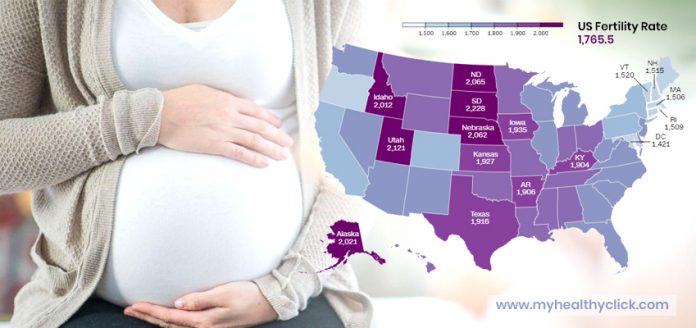U.S. fertility rates have dropped dramatically almost in every state. The rates have dropped under what is necessary to sustain our population levels.
According to a new CDC report, the U.S. fertility rate is the lowest as it has been in 30 years.
The total fertility rate in the United States in 2017 is said to be dipped below what is needed for replenishing ourselves.
As per the report published on Thursday, in 2017, amongst the 50 states, the total fertility rate was 1,421 per 1,000 women in the District of Columbia and 2,227.5 births per 1,000 women in South Dakota, a difference of 57%. Utah also has a total fertility rate above 2,100 per 1,000 women.
In general, the U.S. fertility rate in 2017 was 1,765.5 per 1,000 women – this was approximately 16% below what is considered to maintain or replace our population. So, our national rate is 1,765, which is quite low when compared with what it has been in 30 years.
What we need is a rate of an overall 2,100 births per 1,000 women to maintain our population level. Fortunately, only South Dakota and Utah met those standards.
Researchers said that this kind of baby drought is the worst the states have seen in probably the last three decades, warning that it is not just limited to whites, the rate for all races altogether is now 16 percent lower than what is required to sustain current population levels. Unless this thing reverses, health experts warn there will be insufficient healthy young workers to replace the burden of our aging population.
Researchers blame economic insecurity, late marriages, greater availability of contraception, and a sharp dip in teen pregnancies for such a low fertility rate. Further, they went on to explain that baby drought is not due to a single factor, but a combination of the aforementioned factors.
This type of trend seen in the U.S. is also seen in other developed countries, including Western Europe, said a renowned professor, Dr. John Rowe, at Columbia University. He also explained that one of the important factors driving this trend is the changing roles of women in the society; they are getting married late; they are leaving home and planning their family later in life.
The executive director of American Public Health Association, Dr. George Benjamin, said we have been noticing the total fertility rate going down and it has a lot to do with both women and men, especially couples, who have control on their reproductive lives.
Dr. Helen Kim, an associate professor at Northwestern University’s Feinberg School of Medicine, reckons women may not realize that fertility declines as the age advances and there are a few limitations when it comes to fertility treatments.
A program director for the NYU Langone Fertility Center, Dr. James Grifo, said In-Vitro-Fertilization (IVF) is becoming more and more popular and many young women prefer freezing their eggs to protect themselves from fertility issues in the future.
According to a survey done in 2018 on Americans for delaying reproduction, many young women often feel forced to select between motherhood and their career because of inadequate paid maternity leaves and affordable childcare. Others eschew reproduction until they could pay off their loan debts or afford a house – the expectations that people are finding impossible to meet. Undeniably, it is not surprising that the two states – South Dakota and Utah – with birthrates surpassing the population replacement rate are also the best economic performers for 2017.























